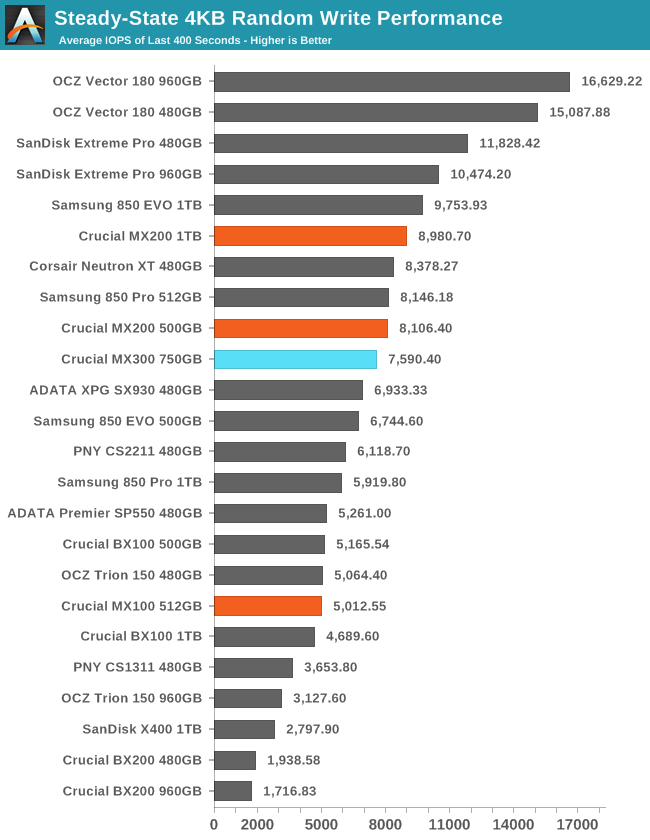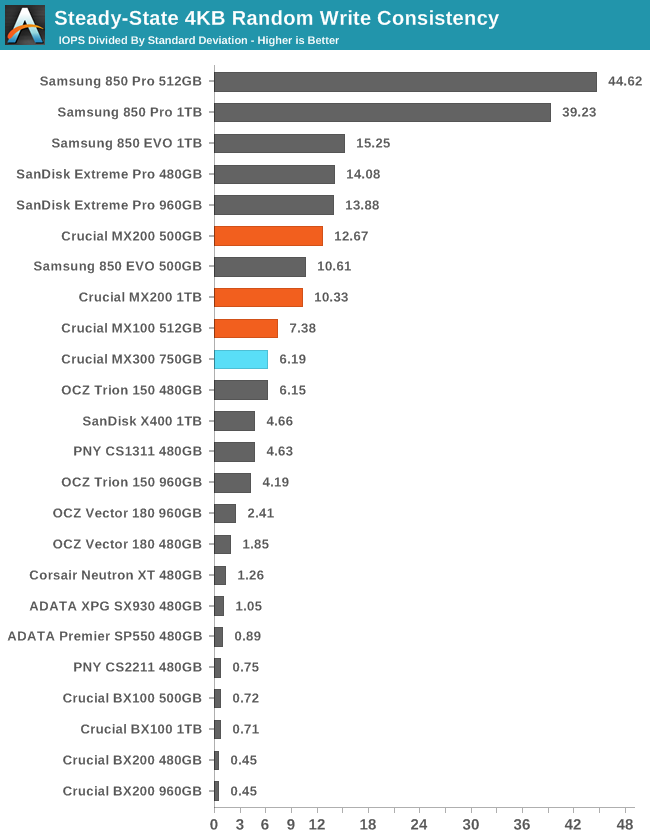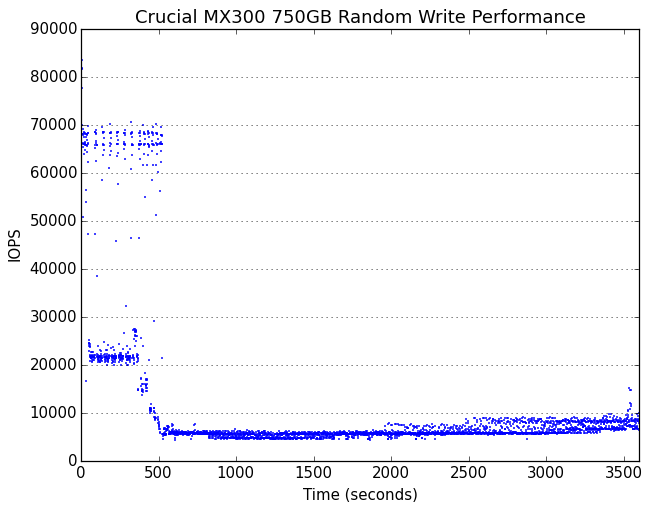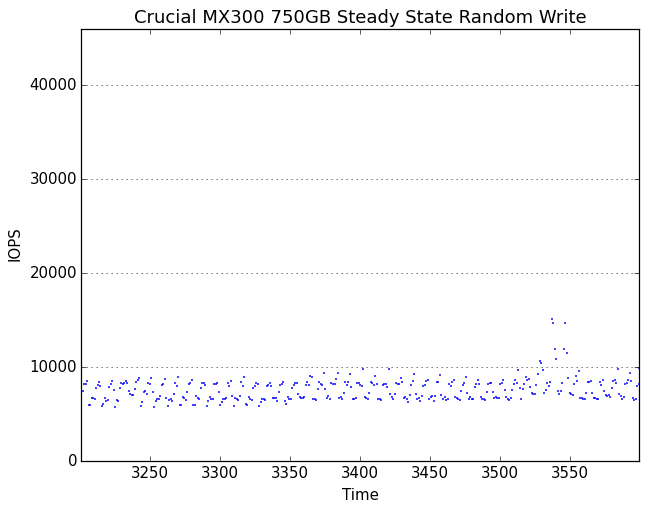The Crucial MX300 750GB SSD Review: Micron's 3D NAND Arrives
by Billy Tallis on June 14, 2016 9:00 AM ESTPerformance Consistency
Our performance consistency test explores the extent to which a drive can reliably sustain performance during a long-duration random write test. Specifications for consumer drives typically list peak performance numbers only attainable in ideal conditions. The performance in a worst-case scenario can be drastically different as over the course of a long test drives can run out of spare area, have to start performing garbage collection, and sometimes even reach power or thermal limits.
In addition to an overall decline in performance, a long test can show patterns in how performance varies on shorter timescales. Some drives will exhibit very little variance in performance from second to second, while others will show massive drops in performance during each garbage collection cycle but otherwise maintain good performance, and others show constantly wide variance. If a drive periodically slows to hard drive levels of performance, it may feel slow to use even if its overall average performance is very high.
To maximally stress the drive's controller and force it to perform garbage collection and wear leveling, this test conducts 4kB random writes with a queue depth of 32. The drive is filled before the start of the test, and the test duration is one hour. Any spare area will be exhausted early in the test and by the end of the hour even the largest drives with the most overprovisioning will have reached a steady state. We use the last 400 seconds of the test to score the drive both on steady-state average writes per second and on its performance divided by the standard deviation.

The MX300's steady state random write performance is below the MX200 but stays slightly ahead of the 850 EVO and well ahead of any planar TLC drive.

The MX300 earns a consistency score that is below the MX200 but about average, and certainly high enough for ordinary consumer workloads.
 |
|||||||||
| Default | |||||||||
| 25% Over-Provisioning | |||||||||
The MX300 lasts for over eight minutes before the SLC cache and spare area are completely exhausted, but during that phase it alternates between operating at about 22k IOPS and 65-70k IOPS. During the steady state phase there is gradual improvement in performance along with an increase in variability.
 |
|||||||||
| Default | |||||||||
| 25% Over-Provisioning | |||||||||
The steady state random write performance of the MX300 varies periodically between about 6k IOPS to 10k IOPS, with no outliers of slow performance. With extra overprovisioning performance is substantially higher and consistency is a bit better.










85 Comments
View All Comments
hechacker1 - Tuesday, June 14, 2016 - link
Is the driver not included with Windows 10 yet?Billy Tallis - Tuesday, June 14, 2016 - link
Windows 8.1 includes basic NVMe support and will boot from a NVMe drive with no trouble. Windows 10 added support for some of the more obscure features like the administrative commands necessary for secure erase. But the driver loading that has the most potential to affect boot performance is the UEFI NVMe driver, which some motherboards might not load until after probing for the existence of any NVMe devices that they would need to inspect for the presence of a bootloader.Impulses - Tuesday, June 14, 2016 - link
Don't see how that's possible unless your needs are pretty basic and sufficiently sated by a single drive, maybe two, in which case you probably don't need the performance of a PCI-E drive...Running a smaller 256GB SM951 here and two SATA 1TB 850 EVO, the only thing I see changing in that equation is going to 512GB for the OS apps drive and to multiple 2TB drives on the SATA side.
Whether PCI-E drives should cost more than SATA ones or not isn't the issue, they're gonna keep carrying a premium as long as they're only really useful to a small niche... The only thing that will potentially lower prices quickly is their common use on laptops, but they can also opt for lower end SATA M.2 drives.
Lolimaster - Saturday, June 18, 2016 - link
The main things most of the users notices changing and HDD for an SSD is the orders of magnitude lower latency/access time and 4k/4k random performance.That's why unless you have an specific need for faster transfer rates people wont notices differences between pcie/sata ssd,
smilingcrow - Tuesday, June 14, 2016 - link
“The lack of significant competition in the PCIE3.0 X4 NAND drives bringing down prices quickly is disconcerting.Buying into SATAIII SSDs at this point in time simply is a bad idea comparatively.”
But on the other hand buying into PCIe drives at this point when the pricing is so high when for many users the benefits over SATA drives is minimal for general usage makes them a bad idea relatively.
azazel1024 - Wednesday, June 15, 2016 - link
Or, you know, for all of the folks who don't have a chipset or board that supports m.2, let alone m.2 PCI-e drives currently. I am still rolling an Ivy Bridge. No m.2 anywhere in my system, and frankly the extra cost to go with an M.2 to PCI-e bridge card, to then pay a premium on an m.2 PCI-e based drive to then drop in...and not confident my board can actually boot from PCI-e storage...Yeah, SATA for me. Frankly drives are cheap enough it isn't that big a deal if I end up dropping $70-80 on an MLC 240GB drive that I use for a couple of years before shuffling it off in to my server as it's boot drive and get an m.2 PCI-e ~480GB drive or similar when finally upgrading my computer to Kaby/Castle.
One benchmark that I wish Anand would do that I have seen a few other sites do are some of the PRACTICAL benchmarks. Such as application load times, or other disk intensive operations to compare between drives, especially between "empty" and "full" states.
Do many users care if Photoshop launches in 5.2s versus 6s of a slower drive? Possibly not, but there probably are some who do. What about reloading 50 web browser tabs? Or loading 100 RAW images from disk in photoshop? A handful of real world tests would be nice to provide some more perspective too. The few sights that do, do that kind of stuff, MLC drives generally seem to have a pretty commanding lead over MLC. Again, many users might not care about shaving a second or two off an application launch time, but some do.
Impulses - Wednesday, June 15, 2016 - link
I went with an M.2 boot drive after seeing the difference it makes in some demanding Adobe tasks on HardOCP's reviews (of the 750 IIRC), but I chose an SM951 with confidence based largely on AT's exhaustive reviews... So yeah I'd agree, some practical tests beyond the patented AT torture tests would be nice, specially at this juncture where some people are still asking whether PCI-E/M.2 is for them... At the end of the day tho, the old cliche probably serves most well, if you even gotta ask then you're probably fine with a SATA drive.Billy Tallis - Thursday, June 16, 2016 - link
Our AnandTech Storage Bench Light, Heavy and Destroyer tests are the tests you're looking for. They're composed entirely of real-world I/O from things like Photoshop, web browsing, gaming, virus scanning, software development and virtual machine use. It wouldn't be useful for us to report dozens of subscores breaking out each individual application: that's an overwhelming amount of data to present and contextualize, short tests of individual applications are harder to make repeatable and valid with high enough resolution, and if you have a single specific use that is most important to you, our synthetic benchmarks probably cover that. Instead we present and analyze three different real-world mixes of I/O.Impulses - Friday, June 17, 2016 - link
It's just hard to translate the results from the Storage Bench to real world impact Billy... Sometimes people just like knowing "oh, it'll actually cut that workload in half". Some may be able to extrapolate that from the AT Bench but it's not immediately obvious. I don't think anyone's asking for a breakdown of every single app involved in the traces, maybe one or two of the most stressful tho? Just a thought.Lolimaster - Saturday, June 18, 2016 - link
They're not.Unless you move tons of data per day with more than 1 pci-e nvme drive there's no difference between sata and pcie ssd's. PCie ssd uses more power and produces more heat.